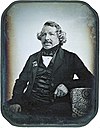User:Fisel/sandbox
List of photographic subjects born in the 1700s
[edit]This is a list of people identified as being among the earliest photographic subjects, sorted by date of birth.
Early photographic portraiture processes
[edit]The first widely available photographic portraiture technique was the daguerreotype, invented in 1839 by Louis Daguerre. Tens of thousands survive today in public collections. The first paper negative process, in which more than one copy could be produced, was the calotype, invented in 1841 by William Henry Fox Talbot. The photographic era had begun. The question is, which sitters that we can document today hold the distinction of being the earliest born human subjects for which photographic likenesses survive?
How old?
[edit]If a centenarian was photographed shortly after the invention of these processes, it is possible that the earliest born human subject with a photographic likeness could have been born in the 1730s.
Photographic subjects born in the 1700s
[edit]| Image | Who | Dates | Country | Photographer | Process | Date of image | Where held | |
|---|---|---|---|---|---|---|---|---|

|
Albert Gallatin, Swiss-American politician and diplomat | 29 January 1761 – 12 August 1849 | USA | Mathew Brady | Sixth plate daguerreotype, gold toned | between 1844 and 1849 | Library of Congress Prints and Photographs Division[1] | |

|
Hugh Brady, general | 29 July 1768 – 15 April 1851 | USA | Mathew Brady | Half plate daguerreotype, gold toned | between 1844 and 1851 | Library of Congress Prints and Photographs Division[2] | |

|
Renty Taylor, Congo-born slave, subject of Louis Agassiz | c1775 – after 1850 | USA | Louis Agassiz | Louis Agassiz's Slave Daguerreotypes, 1850 | Peabody Museum, Harvard University | ||

|
Lyman Beecher, Presbyterian minister, father of Harriet Beecher Stowe | 12 October 1775 – 10 January 1863 | USA | Mathew Brady | Glass, wet collodion | between 1855 and 1863 | Library of Congress Prints and Photographs Division[3] | |

|
William Yarrell, zoologist | 3 June 1784 – 1 September 1856 | England | Unknown | 'Hand-tinted photographic portrait' | 1840 | unclear[4] | |

|
Louis-Jacques-Mandé Daguerre, photographer | 18 November 1787 – 10 July 1851 | France | Jean-Baptiste Sabatier-Blot | Daguerreotype | 1844 | George Eastman House, Rochester, New York | |
| Roger S. Baldwin, Governor of Connecticut | 1793-1863[5] | USA | Mathew Brady | Daguerreotype | between 1844 and 1860 | Library of Congress Prints and Photographs Division[6] | George Eastman House, Rochester, New York | |

|
Rev. Henry Anthon, clergyman | 1795-1861[7] | USA | Mathew Brady | Daguerreotype | 1843 or earlier | Library of Congress Prints and Photographs Division[8]
| |

|
George Edmund Badger, Senator from the state of North Carolina. | 17 April 1795 – 11 May 1866 | USA | Mathew Brady | Half plate daguerreotype, gold toned | between 1844 and 1860 | Library of Congress Prints and Photographs Division[9] |
See also
[edit]- Daguerreotypes
- Calotype
- Collodion process
- Daguerreobase
- History of the camera
- Timeline of photography technology
References
[edit]- ^ [http://www.loc.gov/pictures/collection/dag/item/2004663958/ Albert Gallatin, head-and-shoulders portrait, facing front, with walking stick
- ^ [http://www.loc.gov/pictures/item/2004663885/ Hugh Brady, half-length portrait, facing front, in civilian dress
- ^ [http://loc.gov/pictures/resource/cwpbh.02529/ Rev. Lyman Beecher
- ^ Insufficient details on web site of origin Events in the Life of the Rev. Leonard Jenyns in the Year 1830
- ^ Roger Sherman Baldwin
- ^ Rev. Henry Anthon, half-length portrait, facing front, wearing robe, holding book
- ^ John Anthon
- ^ Rev. Henry Anthon, half-length portrait, facing front, wearing robe, holding book
- ^ George Edmund Badger, half-length portrait, facing three-quarters to the left
External links
[edit]- www.daguerreobase.org European Commission FP7 funded non-profit research project
- Library of Congress Daguerreotype Collection
Category:Photographic processes dating from the 19th century Category:19th-century photography

